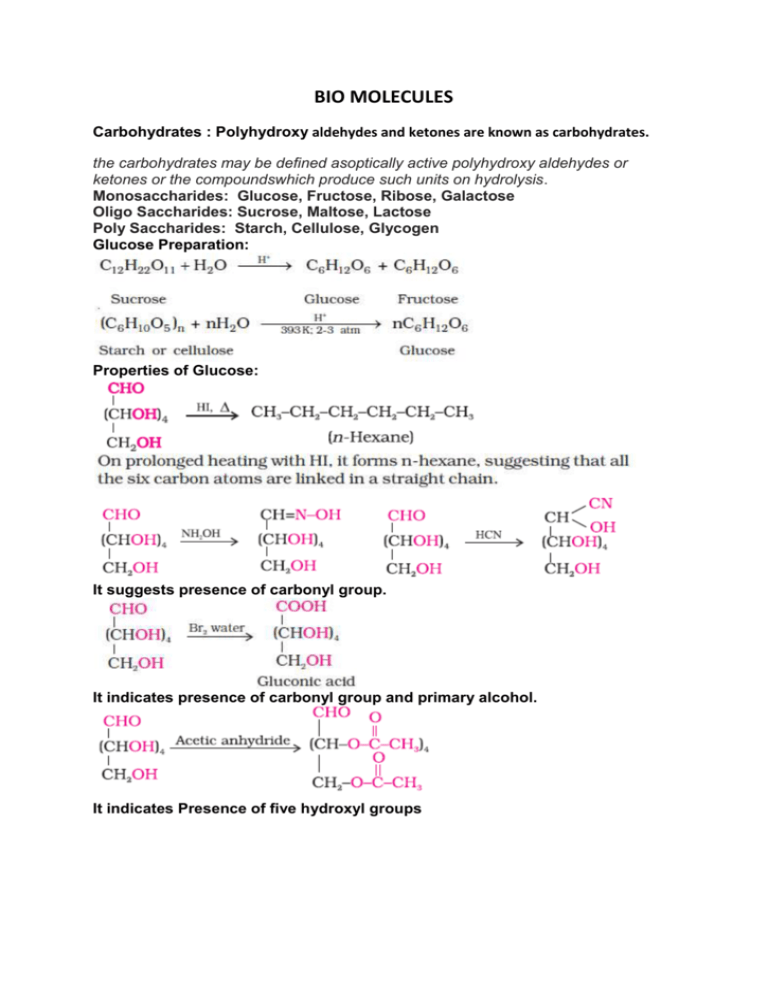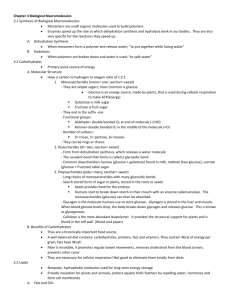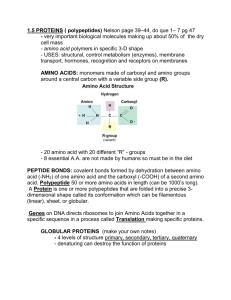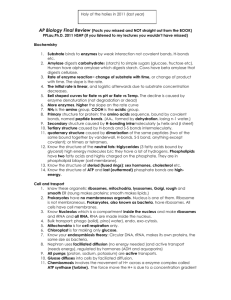SA-1 of Two Marks
advertisement

BIO MOLECULES Carbohydrates : Polyhydroxy aldehydes and ketones are known as carbohydrates. the carbohydrates may be defined asoptically active polyhydroxy aldehydes or ketones or the compoundswhich produce such units on hydrolysis. Monosaccharides: Glucose, Fructose, Ribose, Galactose Oligo Saccharides: Sucrose, Maltose, Lactose Poly Saccharides: Starch, Cellulose, Glycogen Glucose Preparation: Properties of Glucose: It suggests presence of carbonyl group. It indicates presence of carbonyl group and primary alcohol. It indicates Presence of five hydroxyl groups It indicates presence of carbonyl group and primary alcohol Open chain structure of Glucose Reasons Which Could Not Explain Open Chain Structure –(Ring Structure) Ring Structure of Glucose: Ring Structure of Fructose: Di Saccharides: Poly Saccharides: Starch: monomer is alpha D glucose and linkage is C1-C4 & C1-C6 linkages. It has two components like amylase which is water soluble and linear chain polymer of alpha D glucose. And other is Amylopectin which is water insoluble and it is branched chain polymer of alpha D glucose. Cellulose: Its monomer is Beta D glucose with C1-C4 linkage. Glycogen is similar structure as starch and it is also known as animal starch. PROTEINS: Proteins are vital molecules which are made of amino acids. There are 20 amino acids with which all proteins are made. These amino acids are 10 essential amino acids which are important but not synthesized in human body. They must taken through diet. Ex. Valine, Leucine Non essential amino acids synthesized in human body. Ex Glyciene, Alanaine. Zwitter ion Structure of Amino Acids In acid medium Amino Acid has Cationic structure In Basic medium it has anionic structure. At certain PH it has neutral structure this is known as Isoelectric point. Di Peptide: Two amino acids joined by amide linkage between COOH and NH2 this is also known as peptide linkage. Structure of Protein: Its structure is studied under four categories 1. Primary Structure: It is sequential order of various amino acids present in protein chain. 2. Secondary Structure: It explains type of hydrogen bond between carbonyl and amino group. It has two forms. a) Alpha helix due to intra molecular H bond b) Beta Pleated sheet structure: Inter molecular H Bond 3. Tertiary Structure: It explains the folding up of protein chain and gives shape to it. Like Globular protein (water soluble) and Fibrous protein(water in soluble). And inter particle forces are di sulphide, vander waals, hydrogen bond electrostatic forces. 4. Quarternary Structure: Some of the proteins are composed of two or more polypeptide chains referred to as sub-units. The spatial arrangement of these subunits with respect to each other is known as quaternary structure. Denaturation of Proteins: Proteins are sensitive to heat and PH, when it is subjected these it looses its biological activity. And coverts water soluble globular protein into water insoluble fibrous protein. During denaturation primary structure is not affected but higher order structure is affected. Enzymes: enzymes are known as biological catalysts. These can increase the rate of biochemical reactions by many times. Ex. Maltase, zymage liphase. Vitamines: organic compounds required in the diet in small amounts to perform specific biological functions for normal maintenance of optimum growth and health of the organism. Vitamin A,D,E & K are water insoluble but fat soluble. And B (Except B12 ) & C are water soluble. They must be taken regularly. Nuceic Acids: 1. 2 deoxy Ribo Nucleic Acid DNA 2. Ribo Nucleic Acid RNA DNA unit is Nucleotide and made up of 2-de oxy ribose, Nitrogen base (A,G,C,T) and Phosphate group. RNA unit is has Ribose sugar and N base like A, G,C U and Phosphate group. One can understand linkage of nucleic acid by following phosphor di ester linkage from the diagram Note: Structures are for understanding linkage but not important. DNA Structure: 1. Primary Structure: Sequential order of nucleotides 2. Secondary structure: Double helix structure of two strands of Nucleic Acid chains. Two chains are not idential but complimentary to each other. Due to Base pair rule i.e A=G, C≡T Functions of DNA: 1. Replication: DNA molecule is capable of self duplication during cell division and identical DNA strands are transferred to daughter cells. 2. Protein Synthesis: it is in two steps Transcription and Translation S.No. DNA 1 Sugar moiety is 2-Deoxy -D(-) -ribose 2 Cotains thymine and cytosine as pyrimidine bases and guanine and adenine as purine bases 3 Has double stranded helix structure 4 Chiefly occurs in nucleus of cell 5 Very large molecules molecular mass may very from 6 million to 16 million 6 Has unique property of replication 7 Controls transmission of hereditary effects RNA Sugar moiety is D(-) ribose Contains cytosine and uracil as pyrimidine bases and guanine and adenine as purine bases Has single stranded helix structure Mainly occurs in the cytoplasm of the cell Smaller than DNA – molecular mass varies from 20000 to 40000 Does not replicate Controls synthesis of protein VSA of One Mark: 1.Write two main functions of carbohydrates in plants. 2. What is meant by inversion of sugar ? 3. Define the term native state as applied to proteins. 4. What type of bonding helps in stabilising the -helix structure of proteins? 5. What is the effect of denaturation on the structure of proteins? 6. The two strands in DNA are not identical but are complementary. Explain. SA-1 of Two Marks: 1. Answer the following questions briefly (i) What are any two good sources of vitamin A (ii) What are nucleotides? 2. What are essential and non essential aminoacids?Give two example of each 3. Differentiate between (i) Primary strcture and secondary strcture of proteins 4. What do you understand by the term glycosidic linkage? 5. What is glycogen? How is it different from starch? 6. Why Sucrose is Non Reducing sugar? 7. What are the hydrolysis products of (i) sucrose and (ii) lactose? SA-2 of Three Marks: 1. Answer the following questions briefly. (i) What are reducing sugars? (ii) What is meant by denaturation of protein? (iii) How is oxygen replenished in our atmopsphere? 2. Define the following terms (i) nucleotides (b) List out main functions of carbohydrates in organisms. 3. Write the chemical reactions of Glucose with (i) NH2OH (ii) (CH3CO)2O.Also draw simple Fischer projection of D – Glucose and L Glucose. (b) Name the food sources and deficiency diseases caused due to lack of any two of the vitamins A,C,E and K. 4. Classify the following into monosaccharides and disaccharides. Ribose, 2-deoxyribose, maltose, galactose, fructose and lactose. 5. Define the following as related to proteins (i) Peptide linkage (ii) Primary structure (iii) Denaturation.










